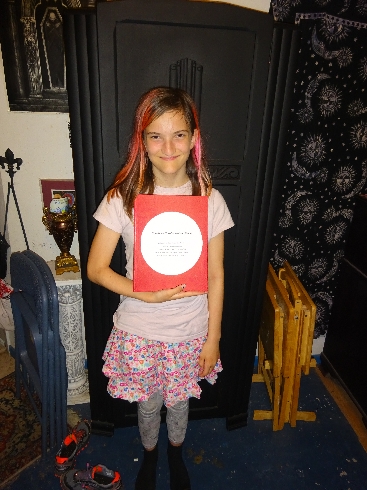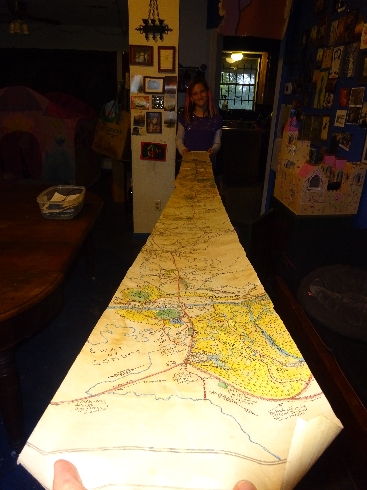 Map of Road
Map of Road As some of you may know, a few years ago I made my daughter a book for her 9th birthday, including both the writing part and the bookbinding. She liked it, so the next year I made another. This is the story of how I made the third and final one.
If you just want to skip to the download link, click hereThe stories involve three hobbit sisters, the future mother and two aunts of Bilbo Baggins. It took me a good bit longer to write this one than the previous two, in part because I had to figure out how to wrap up the loose ends left from the first two. Primary among these, was the identity of the shadowy figure who had been responsible for the machinations which threatened the sisters in the first two books. I had ideas, but had not really decided on who that figure even was. For a while, in my notes to myself as I worked out the plot, I referred to the person as "Whoever Is Is". There were other issues which I had to figure out, and between one thing and another I didn't get the book done in time for Juliet's 11th birthday. Dad fail. But, at least I got it done before the next birthday.
There were also some animals who play important parts in the story, and since discovering the video series "How To Draw Animals", I have found that with some effort I can do good enough drawings of animals in pencil to suit the purpose. The crow is for comedy, and is Juliet's favorite character (animal or otherwise). The dog is Snuffler, who helps with tracking. The fox is a sort of spirit animal for the middle sister, providing some lessons in craftiness that helps her to figure out what is really going on in the story.
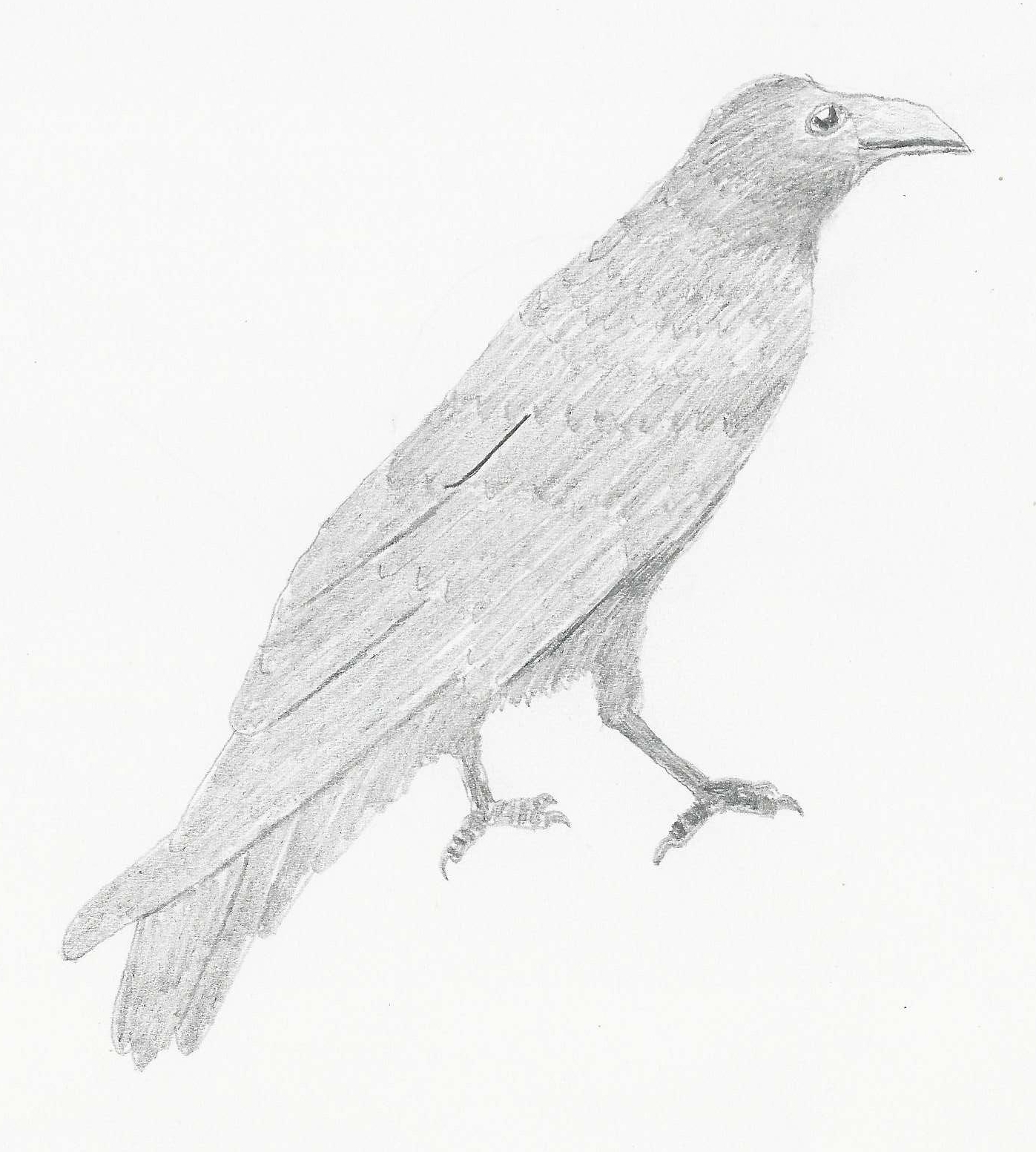
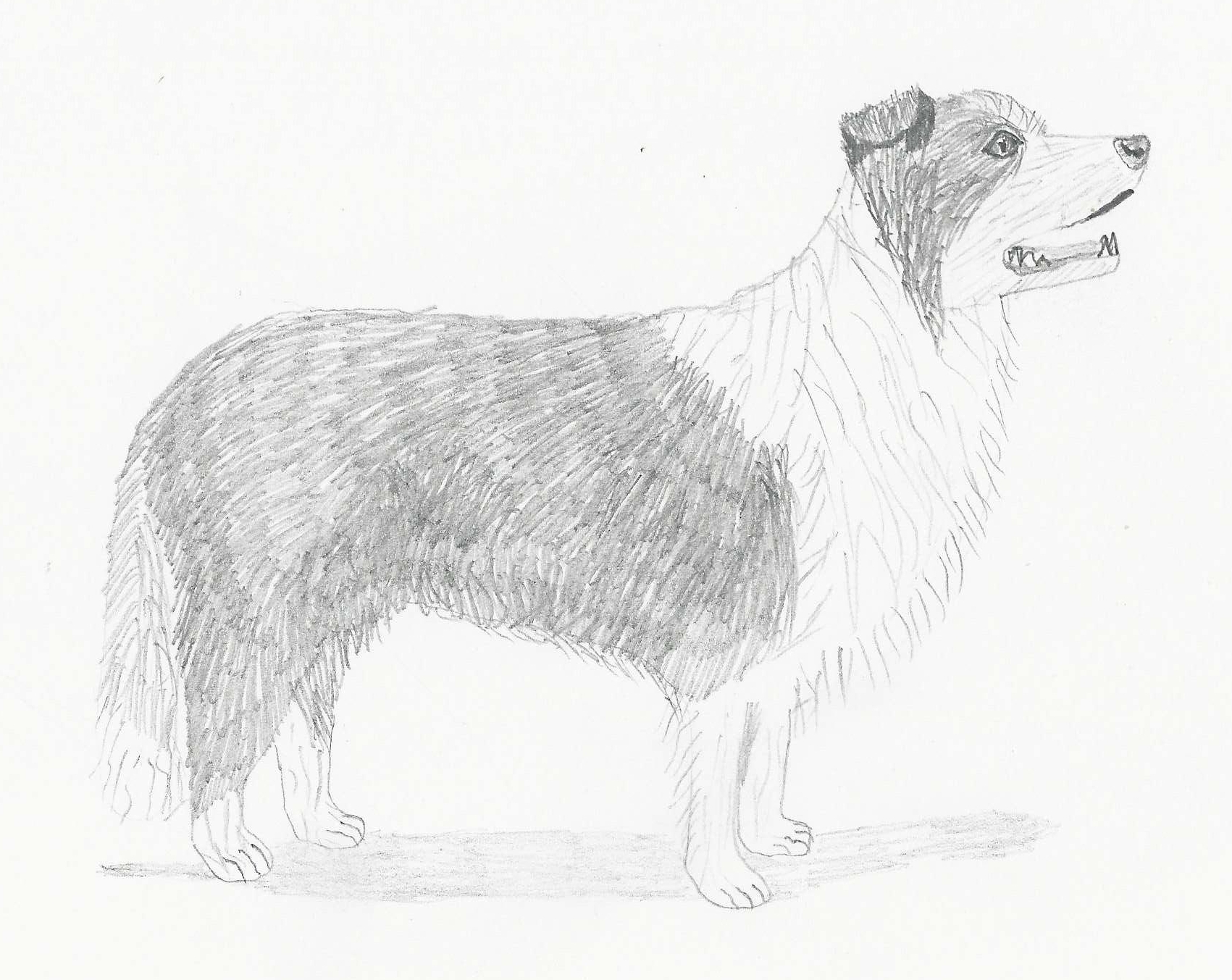
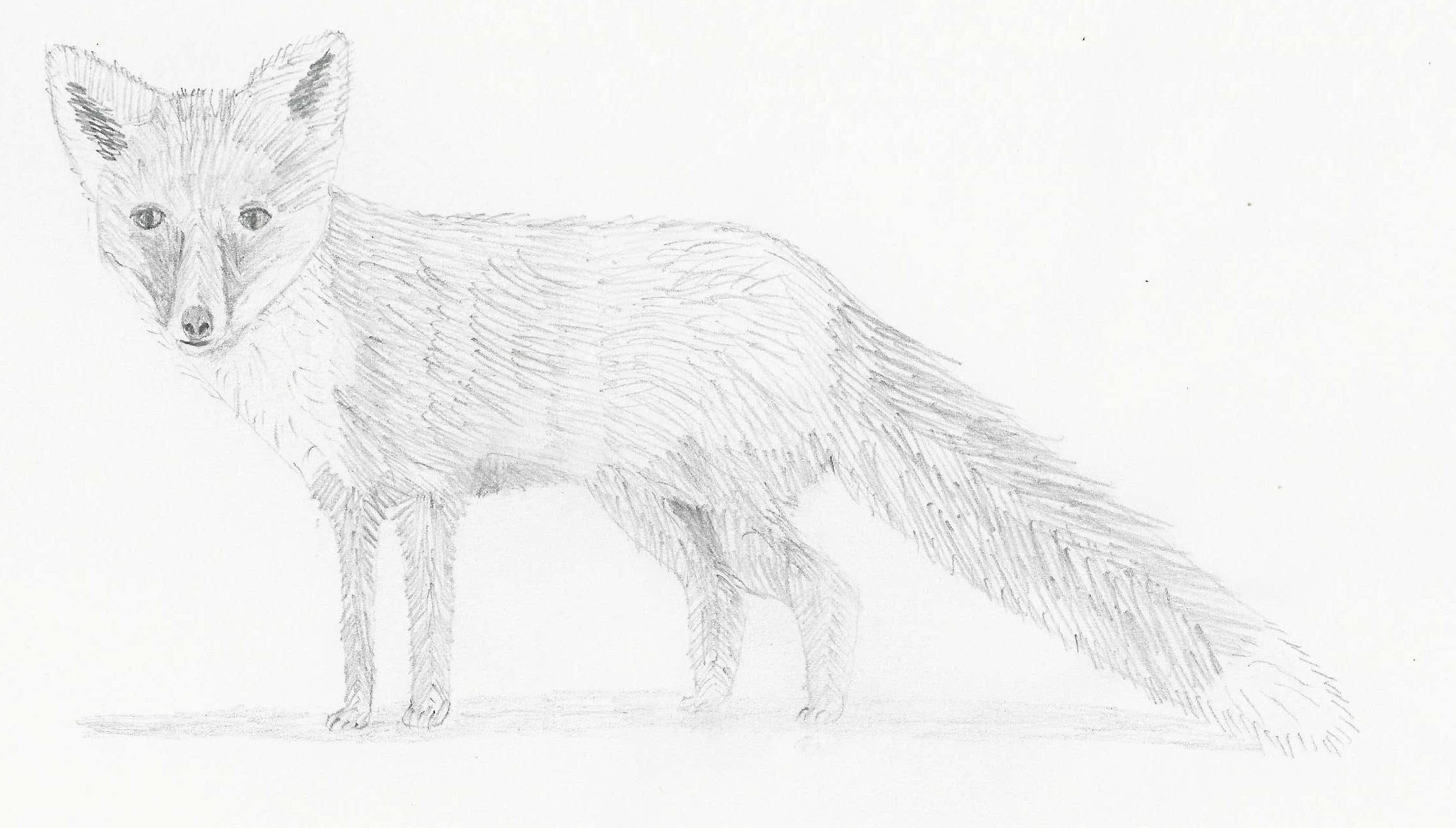
Eventually, I had things worked out in my head, and while I worked on the words, I got some friends to help out with the images which were more demanding than sketches of animals. First, I asked Jonathan Chambers to help me out with the calligraphy. Many of the chapters have a snippet of a letter at the beginning, and it takes a while before the reader learns who wrote it and to whom.
I also needed some maps, and I knew that my friend Patrick Rollinson would do something amazing. I asked him for a map of the road between Fornost Erain (northern ruined capital of the fallen kingdom of Arthedain) and Tharbad (a city on a river far to the south). He made a quite detailed one, and it was not small. I had to scan it in sections, obviously, to put it into the book, but I also showed Juliet the original of course.
I also needed a map of the cities of Fornost Erain (now a ruined fortress) and Tharbad (still inhabited by Men, but fallen quite a bit from its peak). For Tharbad, Patrick made a single map. It was not small.
For Fornost Erain, Patrick made something more like a gazetteer. I sat there just reading it and staring at the pictures for hours, I think. I could only work a fraction of it into Juliet's book of course.
Plus the larger scale maps, of course.
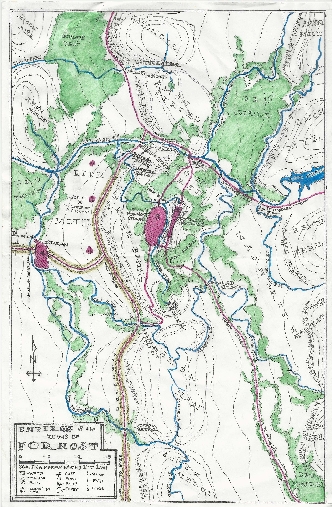 Environs of the ruins of Fornost
Environs of the ruins of Fornost
Lastly, the book ends with family portraits of the three sisters, as adult hobbits. I wanted them to be formal portraits, for the technology level of Hobbits in the Shire. I cannot do that kind of drawing, and Luke Malone who did the art for the last book had a kid in the meantime and thus had little free time available. So, I asked around, and then my wife Cassandra introduced me to the excellent Jennifer Cole. She did a great job of making them look like 20-years-older versions of the original pictures from previous books.
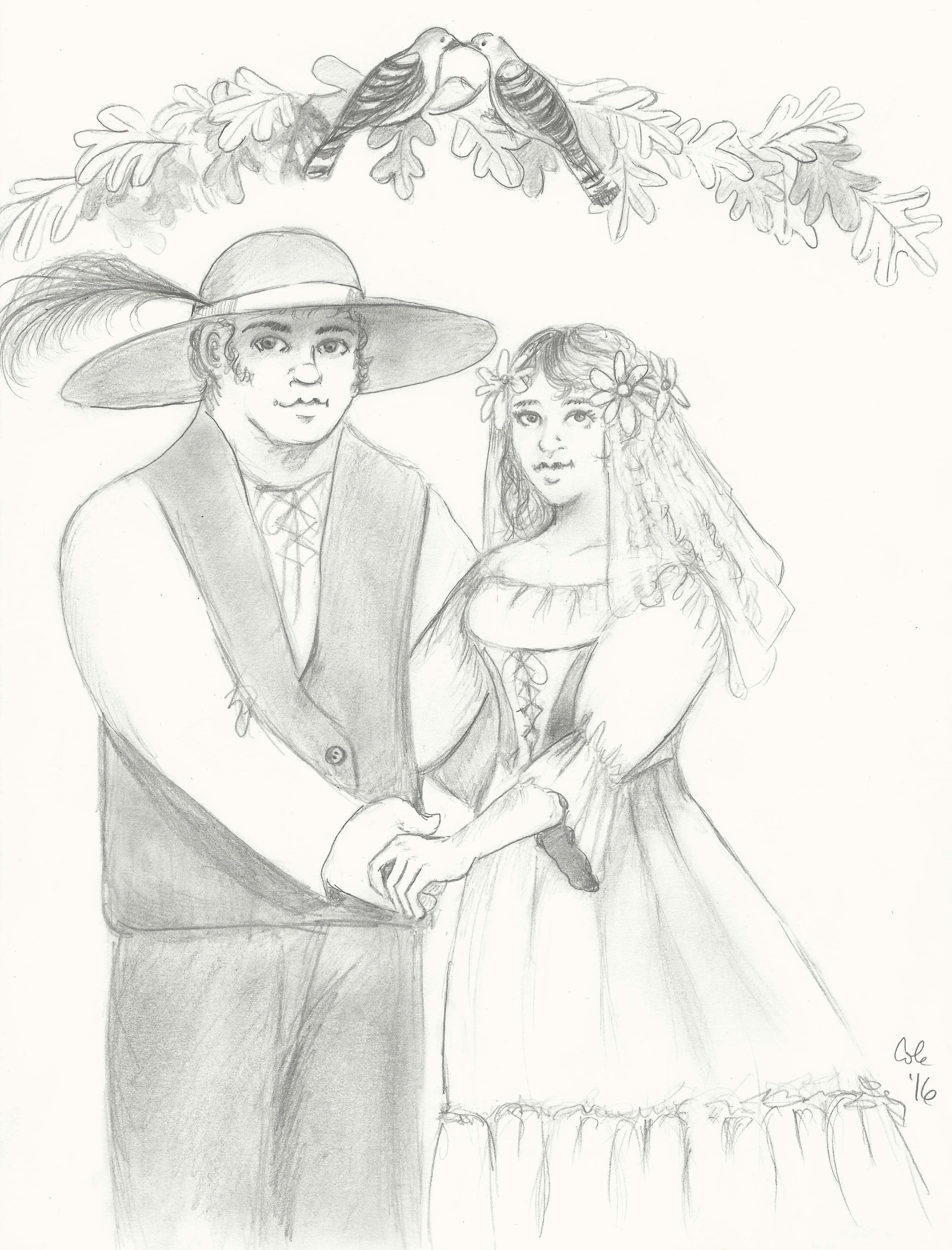
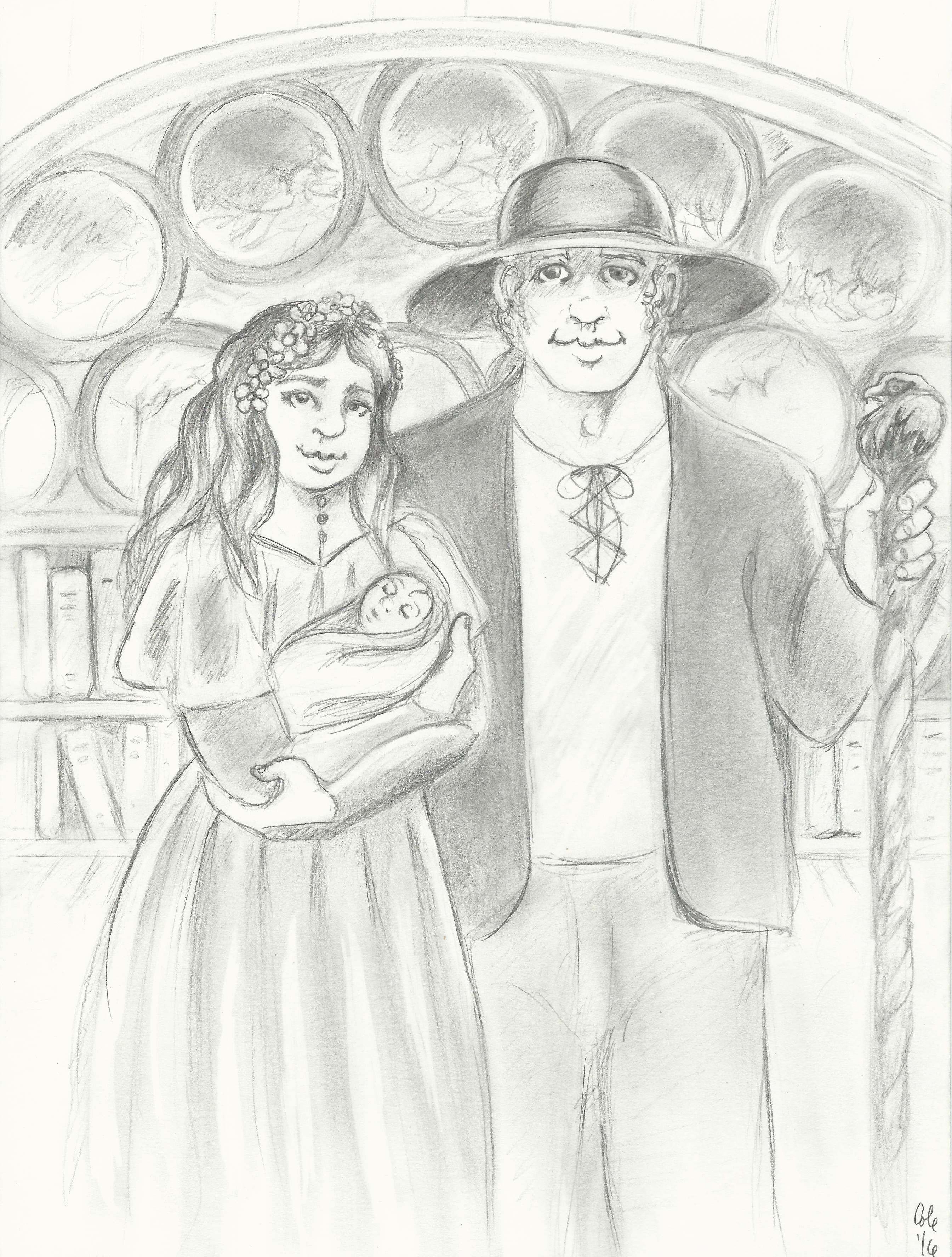
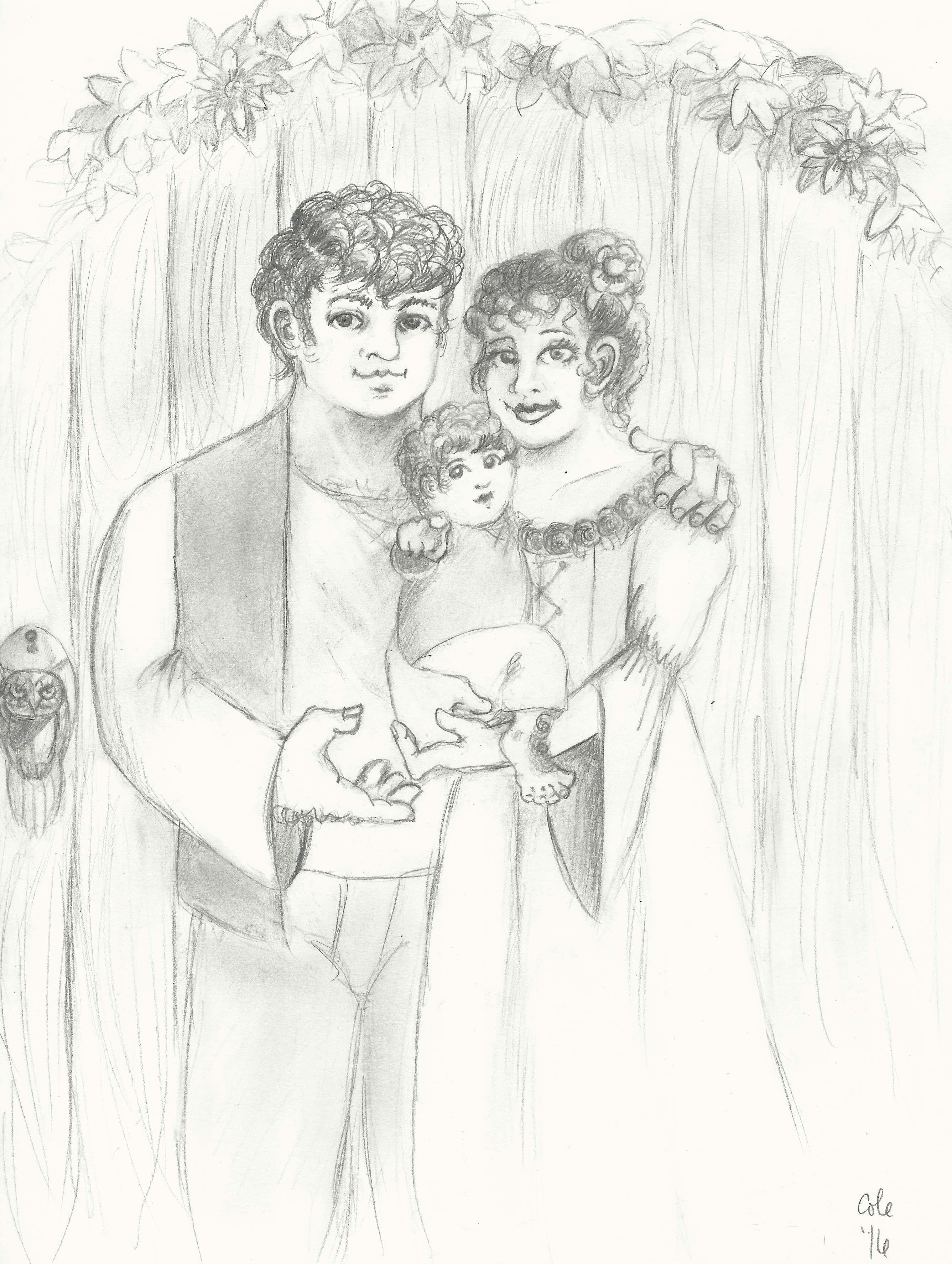
Mirabella, the youngest of the three, is posing with her husband, Gorbadoc Brandybuck. If I am reading my family trees correctly, they are great-grandparents to Merry Brandybuck and Frodo Baggins, from "The Lord of the Rings". Donnamira, the middle sister, is posing with her husband, Hugo Boffin, and her first child, Jago. Belladonna, the oldest sister, is posing with her husband, Bungo Baggins. That's Bilbo Baggins they're holding.
I was quite happy to discover that, unlike a few years ago, nowadays when I export from LibreOffice into a pdf format and combine the pdf's into one big one using python, it keeps the page numbers intact. Of course, better would be if it were to do the page numbering for me, but that is a project for another time. So, no need to use bash code, just python.
# Merge PDFs
from PyPDF2 import PdfFileWriter, PdfFileReader, PdfFileMerger
blankPageFile = open("./blankPage.pdf", "rb")
blankPagePdf = PdfFileReader(blankPageFile)
output = PdfFileWriter()
pdfChapters = []
pdfTitlePageAndTableOfContents = PdfFileReader(open("./TitlePageAndTableOfContents.pdf", "rb"))
pdfChapters.append(pdfTitlePageAndTableOfContents)
pdfChapter1 = PdfFileReader(open("./chapter_1.pdf", "rb"))
pdfChapters.append(pdfChapter1)
pdfChapter2 = PdfFileReader(open("./chapter_2.pdf", "rb"))
pdfChapters.append(pdfChapter2)
pdfChapter3 = PdfFileReader(open("./chapter_3.pdf", "rb"))
pdfChapters.append(pdfChapter3)
pdfChapter4 = PdfFileReader(open("./chapter_4.pdf", "rb"))
pdfChapters.append(pdfChapter4)
pdfChapter5 = PdfFileReader(open("./chapter_5.pdf", "rb"))
pdfChapters.append(pdfChapter5)
pdfChapter6 = PdfFileReader(open("./chapter_6.pdf", "rb"))
pdfChapters.append(pdfChapter6)
pdfChapter7 = PdfFileReader(open("./chapter_7.pdf", "rb"))
pdfChapters.append(pdfChapter7)
pdfChapter8 = PdfFileReader(open("./chapter_8.pdf", "rb"))
pdfChapters.append(pdfChapter8)
pdfChapter9 = PdfFileReader(open("./chapter_9.pdf", "rb"))
pdfChapters.append(pdfChapter9)
pdfChapter10 = PdfFileReader(open("./chapter_10.pdf", "rb"))
pdfChapters.append(pdfChapter10)
pdfChapter11 = PdfFileReader(open("./chapter_11.pdf", "rb"))
pdfChapters.append(pdfChapter11)
pdfChapter12 = PdfFileReader(open("./chapter_12.pdf", "rb"))
pdfChapters.append(pdfChapter12)
pdfChapter13 = PdfFileReader(open("./chapter_13.pdf", "rb"))
pdfChapters.append(pdfChapter13)
pdfChapter14 = PdfFileReader(open("./chapter_14.pdf", "rb"))
pdfChapters.append(pdfChapter14)
print('nbr of pdfs put together is: ',str(len(pdfChapters)))
totalPagesInBook = 0
for chapter in pdfChapters:
totalPagesInBook += chapter.getNumPages()
print('totalPagesInBook',totalPagesInBook)
numBlankPages = 16 - (totalPagesInBook % 16) #one signature is 4 11x17 sheets folded in half (x2) on both sides (x2 again) = 16
print('numBlankPages',numBlankPages)
numStartBlankPages = 2 #magic number!
numEndBlankPages = numBlankPages - numStartBlankPages
#NOTE: I should have also made sure that we have at least a few blank pages at the end
for blankpage in range(0,numStartBlankPages):
output.addPage(blankPagePdf.getPage(0))
totPageNumberSoFar = numStartBlankPages
for chapter in pdfChapters:
chapterPages = chapter.getNumPages()
print('chapterPages',chapterPages)
for page in range(0,chapterPages):
totPageNumberSoFar += 1
output.addPage(chapter.getPage(page))
for blankpage in range(0,numEndBlankPages):
output.addPage(blankPagePdf.getPage(0))
outputStream = open(r"newbook.pdf", "wb")
output.write(outputStream)
outputStream.close()
In case you're interested, here's the whole thing in a single PDF. You could read it to a kid or something. Regarding copyright, I assume that would be the Tolkien Estate's, but really I don't know. Wouldn't be mine, though, I'm pretty sure of that. If the Tolkien Estate tells me to take down the link, of course I will, but probably they don't care as long as I'm not charging for it? For the moment, anyway, here it is, but be warned, it's a large file, so don't click if you don't have a speedy internet connection at the moment.
Full text of the book in pdf form (~32Mb)I'm not going to go over the entire process, because you're better off watching SeaLemon's video tutorial series or reading Aldren Watson's old-school book tutorial if you are wanting to do this. However, I did have a great photographic helper take some pictures of the sewing up part, which I will show you.
This is the part where the pages of the book are printed out, in signatures of four 11x17 sheets (which makes 16 8.5x11 inch pages). A "signature" is just several sheets folded together. There's a sort of shuffling process you have to do electronically on the book format to get it to come out right in signatures, which fortunately I had worked out a couple years ago and so I could just rerun my old software (which is so horribly un-abstracted that I'm not going to show it to you for shame, but it does the job so there).
The signatures are stacked up in order on the sewing frame. Here we are after just two of the signatures are on the frame.
In case you're wondering why they're called "signatures", it's because you "sign" them, as shown in this picture. Why would you do that? Because it minimizes the chance of somehow ending up with a fully bound, sewn and glued up book that has the pages in the wrong order.
The "tapes" are not sticky tapes, they're just strips of cloth which we will sew the signatures onto, that will then get glued to the covers to hold the book together.
Then you sew each signature onto the tapes, so that a single thread (ok actually you occasionally tie on a new piece to extend it) holds the signatures together.
When you add a new signature to the stack, you loop the thread around the one below and keep going. I believe this might be called a "kettle stitch"? SeaLemon has a good video on this.
Then, you make any last-minute corrections which you discover are necessary. (also, you can see an example of Jonathan's calligraphy at the top of the other page in that picture)
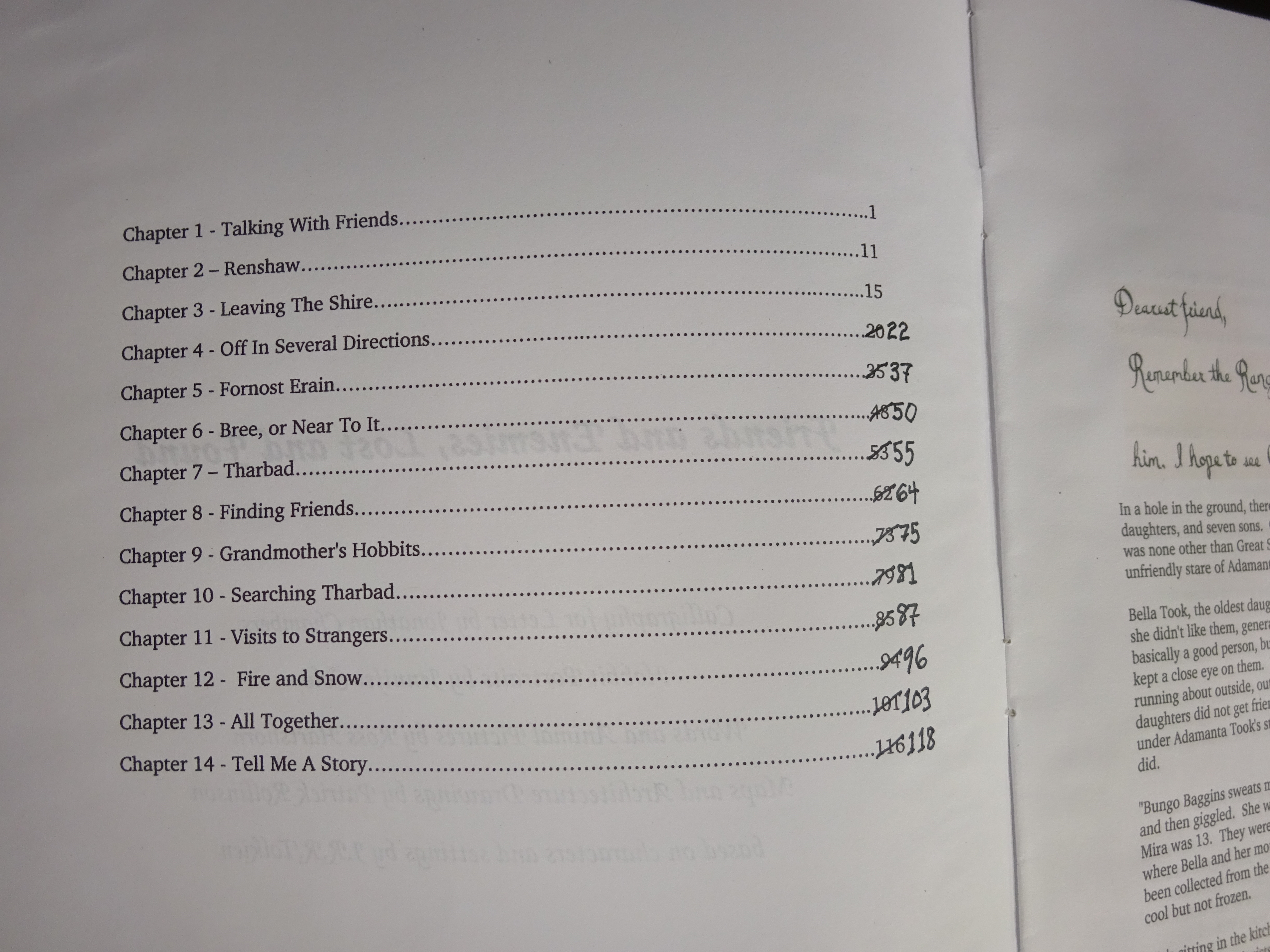
The previous two books had been "done" (that is to say, at least physically in existence as a pile of papers, if not bound together as a book) when our family did its summertime trip to the midwest. Thus, I was able to read them to Juliet as we sat in the car, more or less all in one go.
Since that didn't happen this time, it was winter by the time I had the story together enough (that is to say, at least written and printed out) to read to her. So, we tried something different. I read them to her a chapter at a time, on evenings when it was cold enough to have a fire in the fireplace. This turns out to be a quite nice atmosphere for reading a book, perhaps all the more so because the story takes place in the winter, and some scenes the main characters are even sitting at a campfire. We would pull our two foldup camping chairs out and she would stare into the fire while I would read. More comfortable than reading during a long car-ride, and she never once said, "Can't I watch TV instead?" Which is probably mostly because she is a great kid, but I like to think she didn't mind too much!
